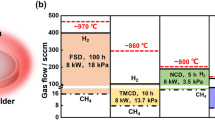Abstract
In this paper we review the physics and the expectations that were put into the negative electron affinity (NEA) mediated field emission of chemical vapor deposition CVD diamond films and how the emitter technology made possible by this mechanism could have challenged the classical metal micro-tip field emitter arrays. We discuss the dependency between emitter performance of micro-tip emitter arrays and feature size (size of the field enhancing tip) and due to this to the connection between emitter performance and fabrication costs.
We introduce the concept of the field enhancement distribution function f(β) for a useful characterization of the field emission properties of thin film emitter and show how this distribution function can be measured by scanning anode field emission microscopy. Using f(β) measured on a thin film of randomly oriented multiwalled carbon nanotubes we show that even these kinds of low cost emitters can show a field emission performance comparable to micro-tip arrays, yet that the large spread in field enhancement values between the individual emitter prevent this performance to be fully exploited. This because the field range in which such thin film emitters can be operated is limited due to emitter disruption and triggering of vacuum arcs. Simulations show how resistor-limited emission can solve these limitations.
Similar content being viewed by others
References
G. Gärtner, P. Geittner, H. Lydtin, A. Ritz, Appl. Surf. Sci. 111 (1997)11
D. Temple, Materials Science and Engineering, R24 (1999)185
M.W. Geis, J.C. Twichell, T.M. Lyszczarz, J. Vac. Sci. Technol. B14 (1996)2060
C. Wang, A. Garcia, D.C. Ingram, M. Lake, M.E. Kordesch, Electron. Lett. 27 (1991)1459
O. Gröning, O.M. Küttel, P. Gröning, L. Schlapbach, J. Vac. Sci. Technol. B17 (1999)1970
O. Gröning, O.M. Küttel, P. Gröning, L. Schlapbach, J. Vac. Sci. Technol. B17 (1999)1064
I. Brodie, C. Spindt, Advances in Electronics and Electron Physics 83 (1992)1
O. Gröning, O.M. Küttel, Ch. Emmenegger, P. Gröning, L. Schlapbach, J. Vac. Sci. Technol. B18 (2000)665
L. Nilsson, O. Gröning, P. Gröning, O.M. Küttel, L. Schlapbach, J. Appl. Phys. in press (2001)
L. Nilsson, O. Gröning, Ch. Emmenegger, O.M. Küttel, E. Schaller, L. Schlapbach, H. Kind, J-M. Bonard, K. Kern, Appl. Phys. Lett. 76 (1999)2071
Author information
Authors and Affiliations
Rights and permissions
About this article
Cite this article
Gröning, O., Nilsson, L.O., Gröning, P. et al. From Diamond to Carbon Nanotube Field Emitter. MRS Online Proceedings Library 675, 611 (2001). https://doi.org/10.1557/PROC-675-W6.1.1
Published:
DOI: https://doi.org/10.1557/PROC-675-W6.1.1




